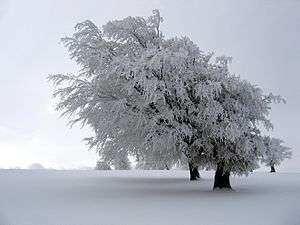Hard rime


Hard rime is a white ice that forms when the water droplets in fog freeze to the outer surfaces of objects. It is often seen on trees atop mountains and ridges in winter, when low-hanging clouds cause freezing fog. This fog freezes to the windward (wind-facing) side of tree branches, buildings, or any other solid objects, usually with high wind velocities and air temperatures between −2 and −8 °C (28.4 and 17.6 °F).
Characteristics
Hard rime formations are difficult to shake off; they have a comb-like appearance, unlike soft rime, which looks feathery or spiky, or clear ice, which looks homogeneous and transparent.
Scientists at meteorologically extreme places such as Mount Washington in New Hampshire often have to break huge chunks of hard rime off weather equipment, in order to keep anemometers and other measuring instruments operating.
Rime ice can accumulate on the leading edges and control surfaces of aircraft operating in certain meteorological conditions. Rime is also a weather form.
Meteorologists distinguish between three basic types of ice forming on vertical and horizontal surfaces by deposition of supercooled water droplets. Of course there are also intermediate formations.
- Soft rime is less dense than hard rime and is milky and crystalline, like sugar. Soft rime appears similar to hoar frost.
- Hard rime is somewhat less milky, especially if it is not heavy.
- Clear ice is transparent and homogeneous and resembles ice-cube ice in appearance. Its amorphous, dense structure helps it cling tenaciously to any surface on which it forms.
Both rime types are less dense than clear ice and cling less tenaciously, therefore damage due to rime is generally minor compared to clear ice. Glaze ice is similar in appearance to clear ice but it is the result of a completely different process, occurring during freezing rain or drizzle.
These three types occur also when ice forms on the surface of an aircraft when it flies through a cloud made of supercooled water liquid droplets. Rime ice is the least dense, milky ice is intermediate and clear ice is the most dense. Dense ice can spoil lift and may have a catastrophic effect on an airborne aircraft.
Formation on snow crystals

Under some atmospheric conditions, forming and descending snow crystals may encounter and pass through atmospheric supercooled cloud droplets. These droplets, which have a diameter of about 10 µm (0.00039 in), can exist in the unfrozen state down to temperatures near −40 °C (−40 °F). Contact between the snow crystal and the supercooled droplets results in freezing of the liquid droplets onto the surface of the crystals. This process of crystal growth is known as accretion. Crystals that exhibit frozen droplets on their surfaces are referred to as rimed. When this process continues so that the shape of the original snow crystal is no longer identifiable, the resulting crystal is referred to as graupel.[1]
The frozen droplets on the surface of rimed crystals are hard to resolve and the topography of a graupel particle is not easy to record with a visible-wavelength microscope because of the limited resolution and depth of field in the instrument. However, observations of snow crystals with a low-temperature scanning electron microscope (LT-SEM) clearly show cloud droplets measuring up to 50 µm (0.00197 in) on the surface of the crystals. The rime has been observed on all four basic forms of snow crystals, including plates, dendrites, columns and needles. As the riming process continues, the mass of frozen, accumulated cloud droplets obscures the identity of the original snow crystal, thereby giving rise to a graupel particle.[1]
See also
References
- 1 2 Rime and Graupel, Electron Microscopy Unit, Beltsville Agricultural Research Center, U.S. Department of Agriculture., retrieved 25 August 2012
External links
| Wikimedia Commons has media related to Category:Hoar frost. |
![]() This article incorporates public domain material from websites or documents of the United States Government.
This article incorporates public domain material from websites or documents of the United States Government.